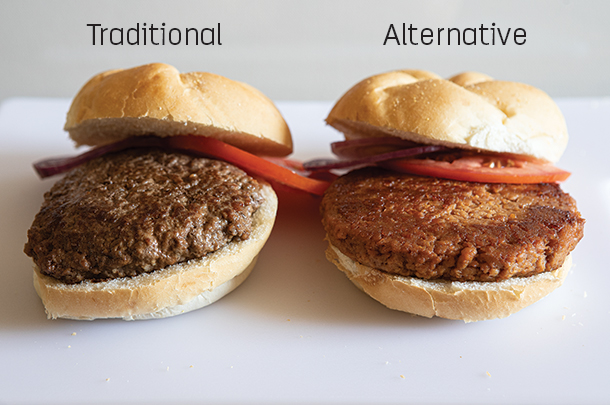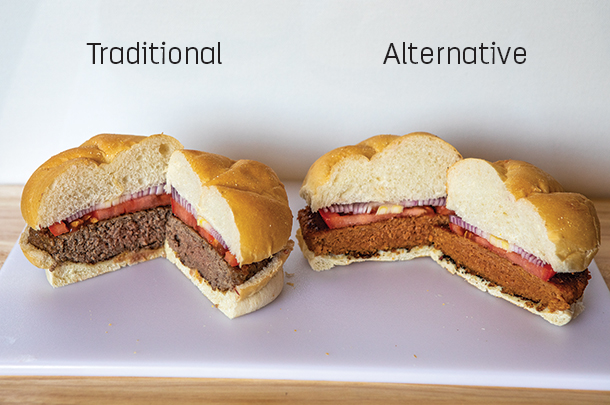“I see that many groups pushing alternatives are demonizing cattle in their marketing and venture capital fundraising materials,” said Van Eenennaam, speaking at the Golden State Dairy Management Conference. “There is no need to propagate misinformation around animal agriculture to develop methods to grow cells in culture. I continue to argue that cattle are more than just hamburgers. They provide important services to the ecosystem, not to mention prime cuts, milk, leather and hundreds of other useful products.”
The alternative animal product arena is complex and quite varied. Some products are entirely plant product-derived and employ only plant origin proteins or metabolites. Other endeavors are using cells of animal origin to derive a more structurally similar meat yet still with animal genomes.
There are two relatively new alternative meat sources touting burgers that are often confused. One is Beyond Burger from Beyond Meat. The burger is made from pea protein isolate. The Impossible Burger from Impossible Foods contains heme, a GMO, which is what causes it to “bleed” when being cooked like animal meat.

“At the end of the day [both] consist of plant-sourced material being molded into a meat substitute-type product,” she said. “They are currently being sold at some fast food restaurants and in supermarkets. Impossible Burger recently received safety approval for its genetically engineered molecule as a color additive in ground beef products.”
These are different from cultured meat, which is the term to refer to animal cells grown in cell culture. This technology has other terminology – some appealing (in vitro meat, cellular meat, fermented meat or slaughter-free meat, clean meat) and some derogatory (artificial meat, synthetic meat, zombie meat, lab-grown meat, non-meat or artificial muscle proteins).

Van Eenennaam said cultured meat requires the initial collection of stem cells from living animals and then greatly expanding their numbers in a bioreactor, a device for carrying out chemical processes.
But is it actually a new phase of industrialization?
“Specifically growing animal cells in a bioreactor for food is, to my way of thinking, industrializing what has historically been a biological process,” she said. “Animals have been producing meat, milk and eggs using biology forever. Replacing that biological system with a bioreactor in a factory fed and controlled by humans using industrial power sources is to me the very definition of factory farming. Large uncertainties remain in what a viable, animal-free, growth media may look like.”
If cultured meat is to match or exceed the nutritional value of conventional meat products, nutrients found in meat, not synthesized by muscle cells, must be supplied as supplements in the culture medium. Conventional meat is a high-quality protein, meaning it has a full complement of essential amino acids. It also provides a source of several other desirable nutrients such as vitamins and minerals, and bioactive compounds.
Van Eenennaam said the biggest problems facing the alternative meat segments are scaling up from being a niche product and being cost-competitive with conventional meat production.
“Therefore, to be nutritionally equivalent, cultured meat would need to provide all of the essential amino acids, along with vitamin B12 – an essential vitamin found solely in food products of animal origin,” she said. “Vitamin B12 can be produced by microbes in fermentation tank and could be used to supplement a cultured meat product. It would also be necessary to supplement iron.”
Cultured meat production will likely require more industrial energy than livestock to produce equivalent quantities of meat. The reason is: All of the biological structures avoided in cellular agriculture play important roles in meat production. An animal’s skin regulates temperature; internal organs digest food, circulate nutrients and distribute oxygen; and the immune system destroys pathogens. When meat is grown in a bioreactor, all the same functions must still be accomplished but at the expense of industrial energy.
“The meat replacement industry is attractive for venture capital,” she said. “There has been more funding available for plant-based alternatives, referred to as ‘novel vegan meat replacement’ brands than there has for cultured meat companies. Beyond Meat is sometimes known as the ‘Bill Gates-backed Veggieburger.’ Leonardo DiCaprio is also an investor.”
“Memphis Meats made meatballs from cultured meat at $18,000 per pound in 2016,” Van Eenennaam said. “Somewhat ironically, given the environmental footprint of airplane travel, Virgin Airlines founder Richard Branson (net worth: $3.8 billion) joined Bill Gates in financing cultured meat leader Memphis Meats in part of a $17 million fundraising round in 2017. Venture capital funds are backing startups in California, Israel and the Netherlands.”
Ground beef is not the only product being attempted in cell-based culture. There are a number of companies springing up making everything from ice cream to egg whites to cow-less milk.
The regulation of cultured meat in the U.S. is currently split between the FDA and the USDA.
Nobody is buying cultured meats because no one has reduced this to practice. But the concept is being sold hard. According to the June 2019 report by consulting firm A.T. Kearney (2019), they predict that “in 20 years, only 40 percent of global meat consumption will still come from conventional meat sources.” They state, “Cultured meat will win in the long run. However, novel vegan meat replacements will be essential in the transition phase.” In their estimation, by 2040 cultured meat will make up 35% of meat consumed worldwide.
Van Eenennaam said what, if any, impact cultured meats will have on the cattle industry remains to be seen.
“I look at the projected increase in demand,” she said. “Beef is projected to go from 63 million metric tons in 2018 to around 90 million in 2040 and milk from 828 MMT to 1,051 MMT in 2040. I do not foresee the demise of grazing ruminants as a food production system and contend that at the current time there is no viable substitute for animal agriculture. It might be worth asking whether all this alternative meat venture capital investment is focusing on the right problem.” ![]()
PHOTOS: While plant-based and cultured (grown in a lab) meat might have some big-name backers, they currently lack the nutrition stats and scale of production of traditional animal agriculture. Photos by Mike Dixon.
Julia Hollister is a freelance writer based in San Francisco, California.





